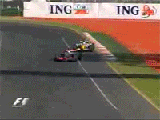I saw the crash live. Spectators were showered with debris. I made a mental note of never, ever buying a front row ticket at restrictor races.modbaraban wrote:On a side note... How on earth a car with bloody spec aero is unsafe enough to go airborne during a trivial spin?!Note: the car took off before the second black Chevy hit it. (video @ 1:22)
Modbaraban, the flaps in the roof are there for that kind of spins, as you know. They take a couple of seconds to open. The flaps work once the car has rotated around 140 degrees, that was more or less the moment of the second "touch".
The first flap axis (the one in the right of the picture) is oriented more or less at 140 degrees respect to the car axis. It works once the car has rotated that amount. Notice we're watching the car from the rear.

Once this first flap opens, "it disrupts the airflow over the roof, killing all of the lift. An area of high pressure forms in front of the flap. This high-pressure air blows through a tube that connects to the pocket holding the second flap, causing the second flap to deploy. The second flap, which is oriented at 180 degrees, makes sure that the car continues to kill the lift as it rotates. After the car has spun around once, it has usually slowed to the point that it no longer produces lift."
You can clearly see the roof flaps opening at the exact second you mention. The second flap had just opened when the car was hit. Besides, the car started to go down when it was hit. If the car hadn't been hit, flaps would have done their work.
BTW, I've wondered many times why F1 cars have not some kind of flaps that prevent them from going airborne. I've suggested to put them in the tray, as I think that the only kind of mortal accident "left" after so many security measures, is the one in which an F1 car goes airborne and lands on its roof.




